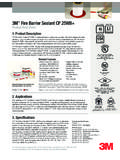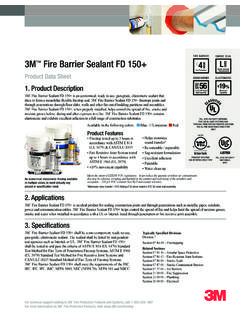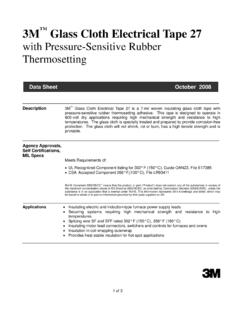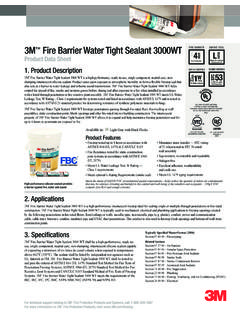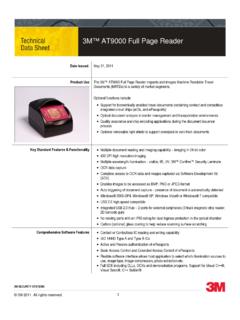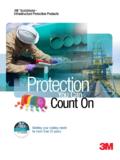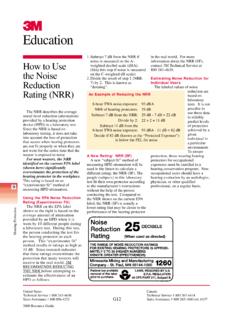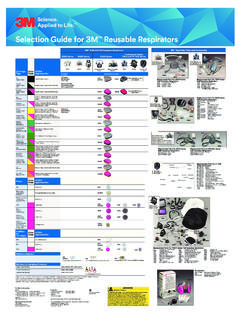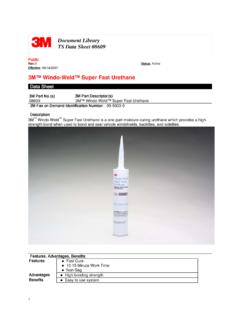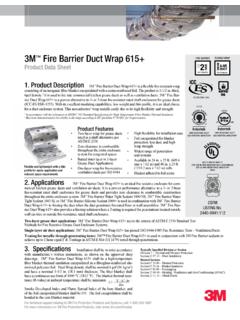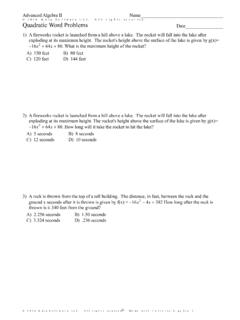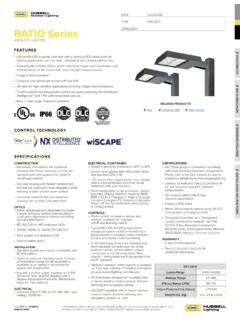Transcription of Adper™ Single Bond 2 Adhesive
1 Adper Single Bond 2 Adhesive technical product profile Adper TM. 2. Table of Contents Introduction ..5. Indications for Use ..7. Background ..8. Physical Properties ..11. Independent Investigations ..13. Technique Guides ..14. Management of Post-operative Sensitivity ..18. Instructions For Use ..19. References ..26. 3. 4. Introduction Product Description Adper Single Bond 2 Adhesive , based on the clinically proven Adper Single Bond Adhesive is a total etch, visible-light activated dental bonding agent incorporating 10 percent by weight of 5nm diameter silica filler. As with the original Adper Single Bond Adhesive , Adper Single Bond 2. Adhesive is indicated for direct light-cured restorative material as well as for the treatment of cervi- cal sensitivity.
2 Adper Single Bond 2 Adhesive may also be used for bonding laboratory fabricated composite or porcelain veneers when used with RelyX Veneer Cement and for bonding amalgam and other indirect applications when used with RelyX ARC Adhesive resin cement. Adper Single Bond 2 Adhesive is available in either a vial or unit dose. The vial incorporates a pinch & flip cap design that minimizes the messiness associated with typical threaded caps. Unlike the standard black, opaque vial used by manufacturers to shield the photoinitiator from all ambient light, the Adper Single Bond 2 vial was designed to shield predominantly the visible light absorbed by the photoinitiator. This design allows for a unique translucent vial that permits visual inspection of the contents.
3 88. 40. 8 Source: 3M ESPE Laboratory 8. 35. B 8. B 8. 8 test data 30. 8. % Light Transmission 8. 25 8. B 8. 20 8. 8. 8. 15 8. B 8 B Photoinitiator Absorbance 10 8. 8 8 New Orange Vial 8. 5. B 8. BB B 8. 0 B8 B8 B8 B8 B8300. 200. B8 B8 B8 8 8400 8 B8 B8 B8 B8600. 8 8 8 8 8500 B B B B B700. B B B B B800. B B B B B900. B B B B B1000. B. Wavelengths, nanometers Figure 1. Selective light absorption of Adper Single Bond 2 vial. Adper Single Bond 2 Adhesive is also offered in a convenient and hygienic unit dose delivery sys- tem. Simply pressing the Single chambered foil package advances Adhesive to the self-contained applicator. Adper Single Bond 2 Adhesive Unit Dose Delivery System 5. Composition Adper Single Bond 2 Adhesive With the exception of the silica nanofiller, Adper Single Bond 2 Adhesive contains the same com- ponents as the original Adper Single Bond Adhesive : BisGMA, HEMA, dimethacrylates, ethanol, water, a novel photoinitiator system and a methacrylate functional copolymer of polyacrylic and polyitaconic acids (see structure in Figure 2) first introduced in Vitrebond Glass Ionomer liner/base and also utilized in Adper Scotchbond Multi-Purpose Adhesive , RelyX Luting Cement and Vitremer Core/Restorative.
4 Incorporation of the polyalkenoic acid into the Adper . Scotchbond Multi-Purpose primer has been shown to aid in resisting the detrimental effect of moisture in an elevated relative humidity environment (Fundingsland et al. 1992). The patented photoinitiator system allows for a fast 10-second light cure. The cure time may be reduced to 5. seconds when using the Elipar FreeLight 2 LED Curing Light. C O C O C O C O C. OH OH OH OH. n Figure 2. Vitrebond polyalkenoic acid copolymer Nanotechnology in Adper Single Bond 2 Adhesive Adper Single Bond 2 Adhesive incorporates 10% by weight of 5 nanometer-diameter spherical sil- ica particles. These silane treated particles are incorporated into the Adhesive through a process that prevents agglomeration.
5 As discrete particles, their extremely small size keeps them in col- loidal suspension. This means you never have to shake Adper Single Bond 2 Adhesive prior to using. In contrast, larger filler particles incorporated into some adhesives are at risk of settling out of solution. Such adhesives require routine shaking before use. Figure 3 demonstrates this difference in suspen- sion stability between the nanoparticles in Adper Single Bond 2 Adhesive and the much larger parti- cles averaging microns in diameter in Optibond Solo Plus Adhesive (filled 15% by weight). Approximately four grams of each Adhesive was dispensed into separate glass vials and tightly capped: Optibond Solo Plus Adhesive was vigor- ously shaken for 10 seconds prior to disensing.
6 Figure 3. (l) Nanofiller in Adper Single Within one week of observation, a phase separa- Bond 2 Adhesive remains in solution;. (r) filler in Optibond Solo Plus does not. tion in Optibond Solo Plus Adhesive became evident. This separation progressed to that shown in Figure 3, which shows Optibond Solo Plus Adhesive after storing undisturbed for approximately 4 months. Conversely, the vial containing Adper Single Bond 2 Adhesive shows no separation after storing undisturbed for approximately 10 months. 6. 3M ESPE Scotchbond Etchant Prior to applying Adper Single Bond 2 adhe- sive, enamel and dentin require a separate etch with phosphoric acid. Scotchbond etchant superficially demineralizes the enamel and dentin in preparation for bonding. The etchant is 35% phosphoric acid by weight.
7 Use of an etchant is critical on both enamel and dentinal surfaces. The phosphoric acid etchant has a pH. of approximately The phosphoric acid gel etchant is thickened to a high viscosity with fumed silica and a water soluble surfactant. The surfactant enables the etchant to be rinsed away more easily. 3M ESPE RelyX Ceramic Primer RelyX Ceramic Primer is a prehydrolyzed, Single -phase silane specifically designed to enhance the bond to ceramic surfaces. Test results have also suggested some benefit of application to metals. Previous testing also suggests that RelyX Ceramic Primer has three years of shelf-life stability. The ceramic primer is required for indirect bonding applications such as porcelain veneers, crown and bridge , inlay/onlays and for porcelain repair.
8 Indications for Use 3M ESPE Adper Single Bond 2 Adhesive is indicated for use in the following types of restorations. Direct light-cured composite/compomer restorations Root surface desensitization Porcelain/composite repair Porcelain veneers (when used with RelyX Veneer Cement). Crown & bridge , inlay/onlay, bonding amalgam (when used with RelyX ARC Adhesive Resin Cement). 7. Background Modern adhesives for bonding restorative materials to tooth structure encompass a range of strate- gies. Currently, a popular strategy in Adhesive dentistry involves the total etch, Single solution Adhesive (also known as fifth generation Adhesive ). The original Single Bond Adhesive , intro- duced in 1997, offered the dental profession the performance of a multi-bottle system in an easy to use, time saving Single bottle system.
9 With the introduction of RelyX ARC Resin Cement in 1998, Single Bond Adhesive expanded its versatility to include bonding amalgam and cementation of laboratory fabricated restorations. The Single Bond Adhesive ease of use philosophy was real- ized with RelyX ARC resin cement as no additional bottles containing accelerants are needed. In 2001, a complementary cement, RelyX Veneer Cement, was introduced specifically for use with Single Bond Adhesive , once again, expanding the versatility of this Adhesive . Adper Single Bond 2 Adhesive offers all the features and benefits of the clinically proven Adper Single Bond Adhesive and introduces new nanofiller technology and the convenience of a unique unit dose delivery. Bonding Mechanism Current dental adhesives rely on a micromechanical bond for adhesion to enamel and dentin.
10 With total etch adhesives the mineral phase of enamel and dentin (hydroxyapatite) is superficially demineralized by an acidic agent in a separate step prior to application of the Adhesive . The acid used is typically a gelled phosphoric acid with a concentration of approximately 35%. On enamel, acid etching greatly increases the surface area available for bonding. Low viscosity, polymerizable resins penetrate the porosities revealed by the etching procedure forming an inter- locking mechanical bond after curing. These interlocking resin tags can be seen in Figure 4. which shows a cross-section of the enamel/ Adhesive bond interface produced with Adper Single Bond 2 Adhesive . Adhesive Resin Tags Figure 4. Scanning electron photomicrograph of Adper Single Bond 2 Adhesive bond to enamel.
